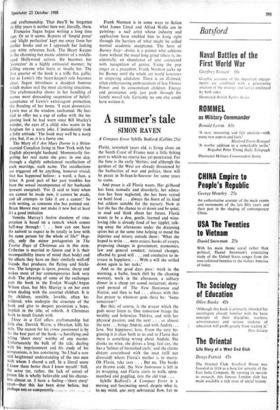NEW NOVELS
Brief candles
BARRY COLE
The Heart Keeper Francoise Sagan translated by Robert Westhoff (John Murray 21s) I Am Mary Dunne Brian Moore (Cape 25s) The Twelve Days of Christmas Venetia Murray (Collins 25s) Three in a Cell Rupert Croft-Cooke (Eyre and Spottiswoode 22s 6d) Barney Snip—Artist Frank Norman (Secker and Warburg 35s)
It is said often enough that anyone can write a novel. The trouble is that anyone often does, much to the chagrin of the reviewer. One ex- cellent test is to ask whether a given novel could have been written by anyone else; if it could, the book is almost certainly rubbish. It is mere coincidence that the five books this week could have been written only by their authois. They may not (they don't) take the novel forward as an art form but they nearly all offer two excellent substitutes : intelligence and craftsmanship. That they'll be forgotten in fifty years is neither here nor, literally, there. Francoise Sagan began writing a long time ago. Or so it seems. Reports of 'limpid prose' and 'slight perfection' kept me away from her
earlier books and so I approach her lacking any witty reference back. The Heart Keeper
is the charming but manic admirer of a middle- aged Hollywood actress. He becomes her 'protector' in a highly antisocial manner; by killing anyone who hurts or insults her. The first quarter of the book is a trifle flat, gallic; but as Lewis's (the heart-keeper) role becomes clear, Sagan introduces a deadpan humour which makes real the most alarming situations.
The craftsmanship shows in her handling of scenes most demanding suspension of belief: acceptance of Lewis's extravagant protection, the flooding of her home. 'I went downstairs. Lewis was at the window, enchanted. He hur- ried to offer me a cup of coffee with the im-
ploring look he had worn since Bill Macley's murder, the eyes of a child who wants to be
forgiven for a nasty joke. I immediately took a lofty attitude.' The book may well be a nasty joke, but, if so, it is a funny one.
The Mary of I Am Mary Dunne is a thrice- married Canadian living in New York with her English playwright husband. Momentarily for- getting her real name she goes, in one day, through a slightly unbalanced recollection of each marriage, each name. The recollections are triggered off by anything, however trivial, that has happened before: a word, a face, a letter. A good part of her past troubles has been the sexual incompetence of her husbands (present excepted). 'For (I said to him) when sex cannot be made new, it cannot be made, and all attempts to fake it are a cancer.' So with writing, as someone else has pointed out. Brian Moore may not make it new but at least it's a good imitation.
Venetia Murray's festive duodene of vitu- peration is based on a remark which comes half-way through : . . how can one have the naivete to expect to be totally in love with the same person for the whole of life?' Hap- pily, only the minor protagonists in The Twelve Days of Christmas are in this state. Catherine is married to Simon and it is their incompatibility (more of mind than body) and the effects they have on their similarly well-off friends that produces the flyting and bitchi- ness. The language is spare, precise, sharp and makes most of her contemporaries look very drab. The phrasing of some of the exchanges puts the book in the Evelyn Waugh/Angus Wilson class, but Mrs Murray is on her own when dealing with the assorted children. It is the children, sensible, lovable, often be- wildered, who underpin the structure of the book and give to deepest pessimism a hope, implicit in the title, of rebirth. A Christmas book to insult friends with.
Three in a Cell offers craftsmanship but little else. Derrick Warre, a librarian, kills his wife. The reason for his crime passionnel is by far the best part of the book—a horrifying and telling 'short story' worthy of any master. Unfortunately the bulk of the tale, dealing with his imprisonment and his study of his companions, is less convincing. `So I had a rare and heightened understanding of the two men with whom I shared a cell. In a literal sense I knew them better than I knew myself.' Still, the sense (or, rather, the lack of sense) of prison life is wholly believable and his charac- ters almost so. I have a feeling—'short story' apart—that this has been done before, but perhaps not so competently.- ,:t.,. (,w)
Frank Norman is in some ways to fiction what James Lloyd and Alfred Wallis are to painting : a naif artist whose industry and application have enabled him to bang right through the barriers of what might be called normal academic acceptance. The hero of Barney Snip—Artist, is a painter who achieves fame without the usual long grind (there is, in- cidentally, an abundance of sex) associated with recognition of genius. Using the pop singer as a precedent, Frank Norman jacks up his Barney until the whole art world kowtows in simpering adulation. There is an ill-timed, often embarrassing embracement of late Flower Power and its concomitant children. Energy and persistence only just push through his faintly moral tale. Certainly no one else could have written it.















































 Previous page
Previous page